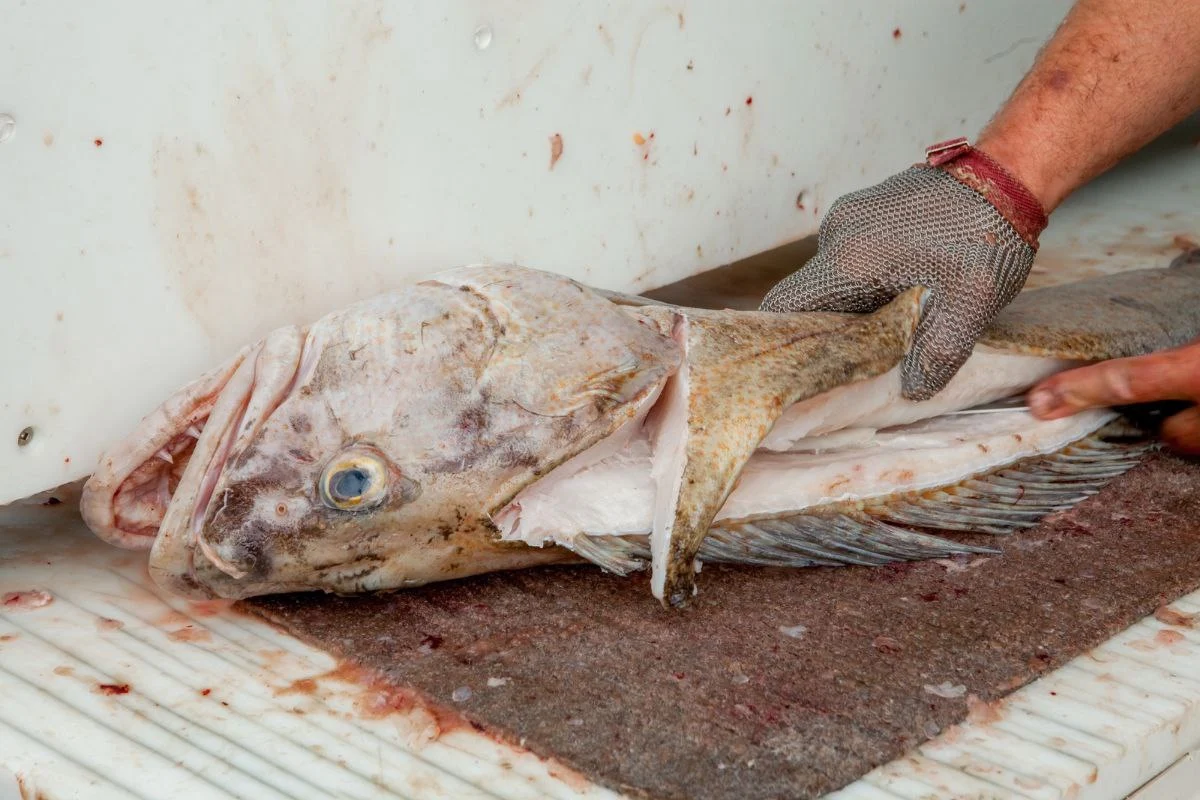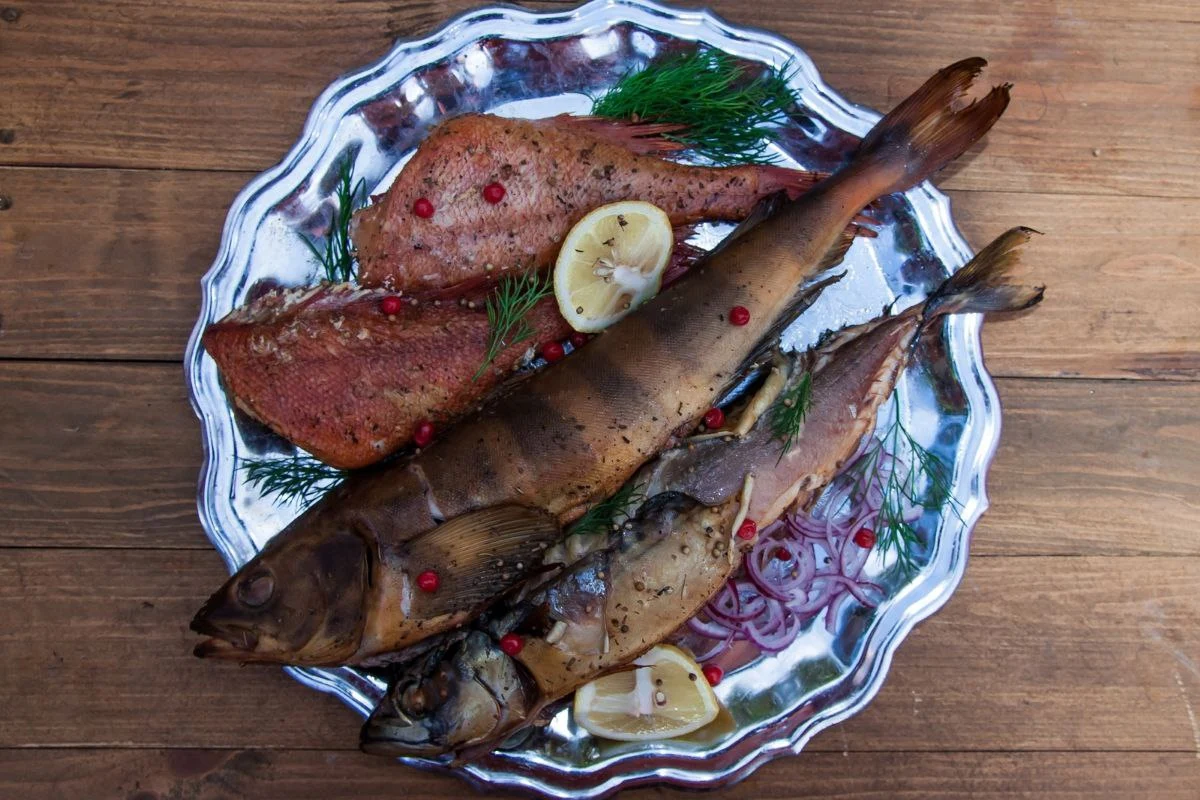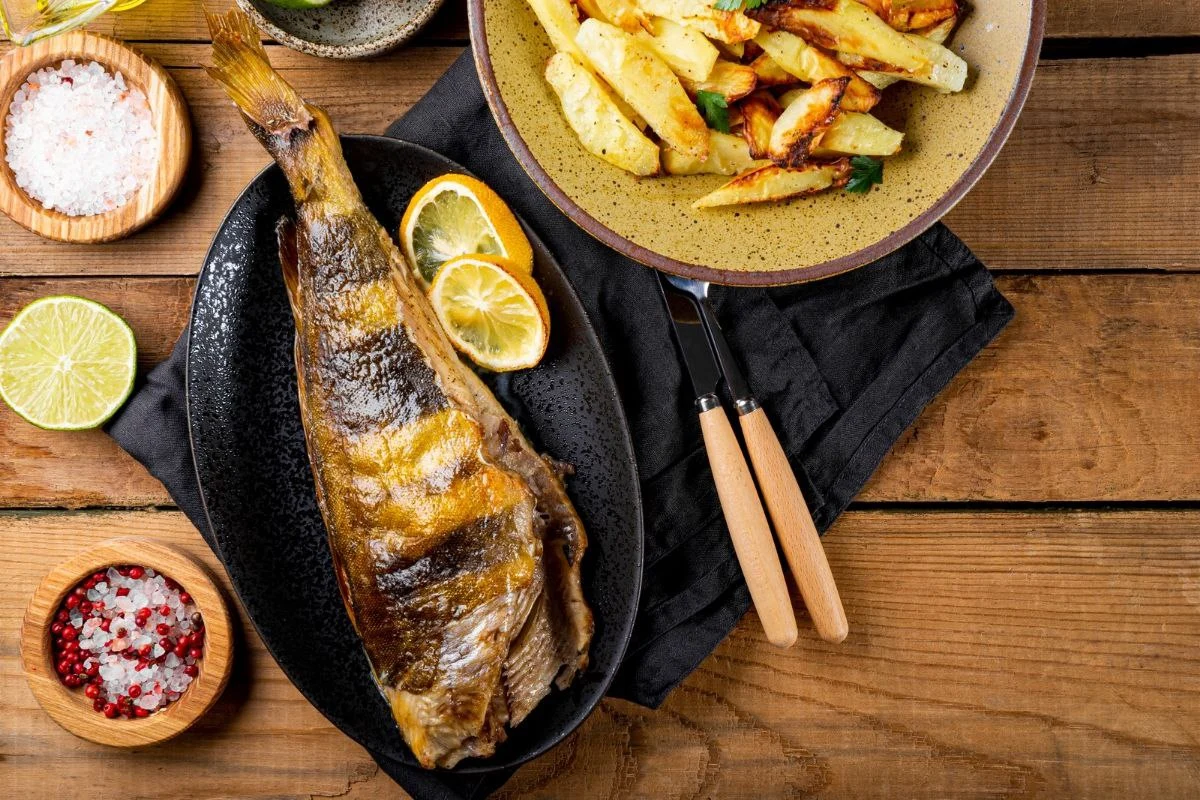Introduction to Lingcod
Lingcod, scientifically known as Ophiodon elongatus, is a fish species native to the North Pacific. Despite its name, it is not a true cod but rather belongs to the greenling family. Lingcod are primarily found along the coasts of Alaska, British Columbia, and down to Baja California. They inhabit rocky bottom environments, ranging from shallow waters to depths of around 300 meters.
The appearance of lingcod is quite distinctive with a large head, elongated body, and a mouth full of sharp teeth, making them formidable predators. Their coloration varies from green to dark brown, speckled with copper or blue spots and blotches, which helps them blend into their kelp and rock-filled habitats. Lingcod are a popular choice among anglers and seafood enthusiasts due to their firm texture and mild flavor, which makes them ideal for various culinary preparations. This species is also valued for its high protein content and beneficial omega-3 fatty acids, making it a nutritious addition to any diet.
Culinary Profile
Nutritional Benefits of Lingcod
Lingcod offers significant nutritional benefits that make it a valuable addition to a healthy diet. As a lean source of protein, lingcod helps in muscle building and repair without the high fat content found in many other protein sources. Each serving provides a substantial amount of protein, essential for maintaining muscle mass and supporting metabolic health.
Rich in omega-3 fatty acids, lingcod contributes to cardiovascular health by reducing blood pressure, lowering triglycerides, and decreasing the risk of heart disease. These fatty acids also play a crucial role in brain function and may help in reducing inflammation throughout the body.
Additionally, lingcod is a good source of vitamins and minerals, including Vitamin D and potassium. Vitamin D is vital for bone health and immune function, while potassium helps in maintaining proper heart function and regulating blood pressure. The low mercury content in lingcod also makes it a safer seafood option, particularly for pregnant women and children.
Preparing Lingcod
Selecting and Storing Lingcod
Selecting fresh lingcod is crucial for both taste and health benefits. Look for bright, clear eyes and firm, shiny flesh that springs back when pressed. The skin should be moist and free of discoloration or dry patches, indicative of freshness. Fresh lingcod should have a mild scent, not overly fishy.
For storing lingcod, refrigerate it as soon as possible after purchase. Wrap it tightly in plastic or place it in an airtight container, and use it within two days. For longer storage, freezing is an option. Wrap the fish tightly in freezer-safe materials, and it can be stored for up to two months without significant loss of quality. Thaw frozen lingcod in the refrigerator overnight when ready to use.
Basic Preparation Techniques
Preparing lingcod for cooking involves a few basic steps to ensure the best culinary results. Start by rinsing the lingcod under cold water to remove any residual scales or impurities. Pat it dry with paper towels to ensure proper cooking techniques can be applied effectively.
To fillet lingcod, lay the fish on a stable cutting surface. Make an incision behind the gills and work the knife along the backbone, separating the fillet from the ribs and removing the skin if preferred. For recipes requiring whole fish, simply clean the inside, removing the viscera, and rinse thoroughly.
Marinating or seasoning lingcod before cooking can enhance its mild flavor. Suitable marinades might include herbs, lemon juice, and garlic, which complement its tender flesh. Always let the fish reach room temperature before cooking to ensure it cooks evenly.
how to cook lingcod

Pan-Seared Lingcod with Brown Butter Garlic Sauce
Pan-seared lingcod with brown butter garlic sauce is a delicious and elegant dish that highlights the mild, flaky texture of the fish. This recipe is straightforward, requiring just a few key ingredients and steps to achieve a restaurant-quality result at home.
Ingredients:
- 2 lingcod fillets, about 6 ounces each
- Salt and freshly ground black pepper, to taste
- 2 tablespoons olive oil
- 4 tablespoons unsalted butter
- 3 cloves garlic, minced
- Juice of 1 lemon
- 1 tablespoon capers, rinsed
- Fresh parsley, chopped, for garnish
Preparation:
- Season the Fillets: Begin by patting the lingcod fillets dry with paper towels. Season both sides generously with salt and pepper. This not only enhances the flavor but also helps in achieving a golden crust.
- Pan-Sear the Lingcod: Heat the olive oil in a non-stick skillet over medium-high heat. Once the oil is shimmering, place the lingcod fillets skin-side down (if skin-on) in the pan. Cook for about 4 minutes or until the bottom is golden and crisp. Carefully flip the fillets and cook for an additional 3-4 minutes, or until the fish is opaque and flakes easily with a fork. Remove the fillets from the skillet and set aside on a warm plate.
- Make the Brown Butter Garlic Sauce: In the same skillet, reduce the heat to medium and add the butter. Let the butter melt until it begins to foam. Stir in the minced garlic and continue to cook until the butter turns a golden-brown color and has a nutty aroma. This usually takes about 2-3 minutes. Be careful not to burn the garlic. Stir in the lemon juice and capers, and remove from heat.
- Serve: Spoon the brown butter garlic sauce over the cooked lingcod fillets. Garnish with freshly chopped parsley. Serve immediately, perhaps with a side of steamed vegetables or a light salad to complement the rich flavors of the dish.
This pan-seared lingcod with brown butter garlic sauce is perfect for a quick yet sophisticated weekday dinner or a special occasion, offering a beautiful balance of flavors that enhance the natural qualities of the fish.
Lingcod with Lemon Caper Sauce
Lingcod with Lemon Caper Sauce is a vibrant and flavorful dish that pairs the mild taste of lingcod with the bright acidity of lemon and the briny punch of capers, creating a delightful balance of flavors. This recipe is simple yet sophisticated, making it perfect for both weeknight dinners and entertaining guests.
Ingredients:
- 2 lingcod fillets, about 6 ounces each
- Salt and freshly ground black pepper, to taste
- 2 tablespoons olive oil
- 1/4 cup dry white wine
- 2 tablespoons fresh lemon juice
- 1 tablespoon capers, drained
- 2 cloves garlic, minced
- 2 tablespoons unsalted butter
- Fresh parsley, chopped, for garnish
- Lemon slices, for serving
Preparation:
- Prepare the Fish: Begin by drying the lingcod fillets with paper towels. Generously sprinkle both sides with salt and pepper. This not only boosts the flavor but also assists in forming a crisp, golden crust.
- Cook the Lingcod: Heat olive oil in a skillet over medium-high heat. Once hot, add the lingcod fillets and cook for about 4 minutes on one side until golden brown and slightly crispy. Flip the fillets and cook for another 3-4 minutes or until fully cooked through and flaky. Remove the fillets from the skillet and keep them warm.
- Make the Lemon Caper Sauce: In the same skillet, reduce the heat to medium and add the garlic, cooking until fragrant, about 1 minute. Deglaze the pan with white wine, scraping up any browned bits from the bottom of the pan. Add lemon juice and capers, and simmer the sauce for a couple of minutes to reduce slightly. Finish the sauce by whisking in the butter until the sauce is smooth and emulsified.
- Serve: Plate the lingcod fillets and spoon the lemon caper sauce over them. Garnish with chopped parsley and lemon slices for an extra touch of freshness.
Lingcod with Lemon Caper Sauce is an excellent choice for a light, refreshing meal that is both easy to prepare and impressively full of flavor. Pair it with a crisp white wine and a side of asparagus or a simple green salad for a complete, satisfying dinner.
Oven-Roasted Lingcod with Lemon Aioli and Wilted Chard
Oven-Roasted Lingcod with Lemon Aioli and Wilted Chard is a wholesome and elegant dish that combines the delicate flavors of the ocean with the zest of lemon and the earthiness of Swiss chard. This recipe offers a delightful mix of textures and flavors, making it a perfect meal for health-conscious diners who do not want to compromise on taste.
Ingredients:
- 2 lingcod fillets, about 6 ounces each
- Salt and freshly ground black pepper, to taste
- 2 tablespoons olive oil
- 1 bunch Swiss chard, stems removed and leaves roughly chopped
- 2 cloves garlic, minced
- 1/2 cup cherry tomatoes, halved
- For the Lemon Aioli:
- 1/2 cup mayonnaise
- 1 tablespoon lemon zest
- 2 tablespoons lemon juice
- 1 clove garlic, finely minced
- Salt and pepper, to taste
Preparation:
- Prepare the Lemon Aioli: In a small bowl, mix together mayonnaise, lemon zest, lemon juice, and minced garlic. Season with salt and pepper to taste. Place in the refrigerator to allow the flavors to blend together.
- Roast the Lingcod: Preheat the oven to 400 degrees Fahrenheit (200 degrees Celsius). Line a baking sheet with parchment paper. Place the lingcod fillets on the sheet and drizzle with 1 tablespoon olive oil; season with salt and pepper. Roast in the oven for 12-15 minutes, or until the fish is flaky and opaque throughout.
- Cook the Swiss Chard: While the fish is roasting, heat the remaining olive oil in a large skillet over medium heat. Incorporate the minced garlic and cook until it releases its aroma, about 1 minute. Add the Swiss chard and cherry tomatoes, and cook until the chard is wilted and the tomatoes are slightly softened, about 5 minutes. Season with salt and pepper.
- Serve: Arrange the wilted chard and tomatoes on plates. Top with the roasted lingcod fillets and a dollop of lemon aioli. The lemon aioli adds a creamy, tangy contrast to the mild flavor of the lingcod and the richness of the wilted chard.
Oven-Roasted Lingcod with Lemon Aioli and Wilted Chard is a nutritious and flavorful dish that is both visually appealing and satisfying. It pairs beautifully with a glass of light white wine, such as Sauvignon Blanc or Pinot Grigio, enhancing the dining experience.
Advanced Cooking Techniques

Grilling and Smoking Lingcod
Grilling and smoking are excellent methods for preparing lingcod, enhancing its mild flavor with smoky, charred notes. Here’s how to get the best results:
Grilling Lingcod: Preheat your grill to medium-high heat. Lightly oil the grill grates to prevent sticking. Season the lingcod fillets with salt, pepper, and your choice of herbs or marinade. Place the fillets on the grill, skin-side down if skin-on, and cook for about 4 to 5 minutes per side or until the flesh is opaque and flakes easily with a fork. The high heat gives a crispy exterior while keeping the inside moist.
Smoking Lingcod: For smoking, use a wood like alder or hickory for a mild, smoky flavor. Preheat your smoker to 225 degrees Fahrenheit. Season the lingcod as desired and place in the smoker. Smoke for about 45 to 60 minutes, depending on thickness. The low, slow heat infuses the fish with smoky flavor while keeping it tender and juicy.
Both methods impart distinct flavors, making lingcod a versatile choice for various palates and occasions.
Using Lingcod in Soups and Stews
Lingcod is an excellent choice for soups and stews due to its firm texture and mild flavor, which absorbs the surrounding spices and broths without falling apart. To incorporate lingcod into soups and stews, start by cutting the fish into bite-sized chunks. Season the pieces with salt and pepper before lightly searing them in a hot pan with a bit of oil. This step helps to lock in the flavors and gives the fish a slight crust.
Add the seared lingcod chunks to your soup or stew in the last few minutes of cooking to avoid overcooking them. Lingcod works particularly well in creamy chowders, tomato-based stews, or clear broths seasoned with herbs and vegetables. The key is to allow the fish to simmer gently until just cooked through, ensuring it remains tender and flaky, enriching the dish with its distinct, succulent texture and taste.
FAQs
-
What is the best way to ensure my lingcod is cooked but still moist?
To ensure that lingcod is cooked yet remains moist, it’s essential to avoid overcooking, which is a common mistake with lean fish. Start by patting the fillets dry and seasoning them to your taste. Cook the lingcod at a moderate temperature — whether you’re baking, grilling, or pan-searing — and keep a close eye on the cooking time. Typically, lingcod should be cooked for about 10 minutes per inch of thickness, checking for an opaque color and flaky texture as indicators of doneness. Employ a meat thermometer to ensure the internal temperature of the fish hits 145 degrees Fahrenheit. Allowing the fish to rest for a few minutes post-cooking aids in preserving its moisture.
-
Can lingcod be used in a fish curry?
Yes, lingcod can be excellently used in fish curry due to its firm texture and mild flavor, which pairs well with robust spices and creamy sauces. To incorporate lingcod into a curry, first cut the fish into bite-sized pieces. Briefly marinate the pieces in a mixture of curry spices and a little lemon juice to enhance flavor. Sear the fish lightly in a hot pan to create a subtle crust before adding it to the curry sauce. This method helps to lock in flavors and prevents the fish from disintegrating during the simmering process. Add the fish towards the end of cooking to ensure it remains tender and absorbs the curry flavors without becoming overcooked.
-
Are there any good substitutes for lingcod in recipes?
If lingcod is unavailable, several good substitutes offer similar textures and flavors suitable for most recipes. Halibut is an excellent alternative, with its firm texture and clean taste, making it versatile for various cooking methods. Rockfish and snapper also work well, especially in dishes that require the fish to hold its shape, such as stews and pan-searing. For a more budget-friendly option, haddock or cod can be used; both are widely available and adapt well to a range of flavors, from mild to robust, making them suitable for recipes calling for lingcod.
-
Is Lingcod a good tasting fish?
Yes, lingcod is considered a good tasting fish with a mild, slightly sweet flavor and a firm, flaky texture. Its taste is often compared to that of halibut or a milder version of cod. Lingcod’s lean white meat absorbs seasonings and marinades well, making it versatile for a variety of cooking methods including baking, grilling, and frying. This adaptability, combined with its pleasant taste and texture, makes lingcod a popular choice among seafood lovers for a wide range of dishes.
-
What is the flavor of Lingcod?
Lingcod has a mild, sweet flavor that’s subtly distinct from other white fish, making it highly appreciated in culinary circles. Its taste is clean, with a delicate hint of sweetness that complements a variety of cooking styles and ingredients. The texture of lingcod is firm and flaky, which allows it to absorb flavors well, whether it’s seasoned simply with salt and pepper or marinated in more robust spices and sauces. This combination of mild flavor and versatile texture makes lingcod an excellent choice for a wide range of dishes, from simple pan-seared preparations to complex, flavorful sauces.
Further Reading and Resources
- For information on sustainable fishing practices for Pacific cod, visit the National Oceanic and Atmospheric Administration (NOAA) Fisheries page.
- Learn more about seafood sustainability standards by checking out the Monterey Bay Aquarium Seafood Watch.
- For expert cooking tips, explore the culinary resources available at Epicurious.
